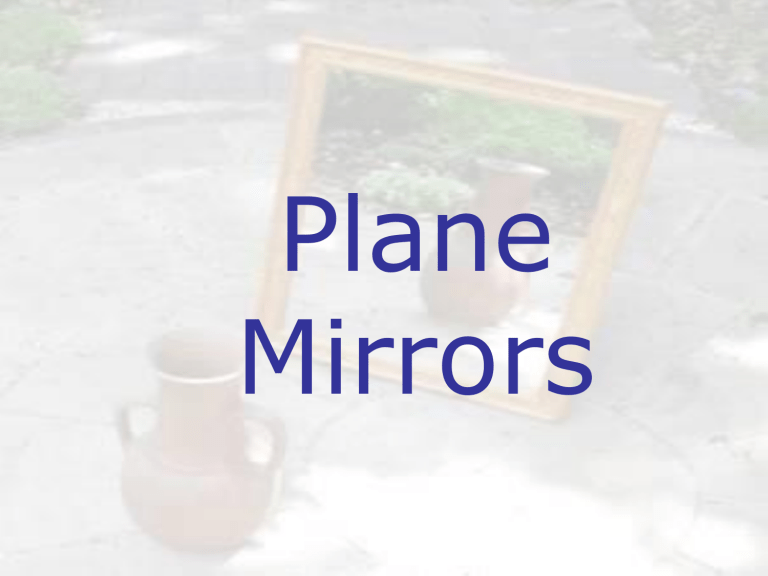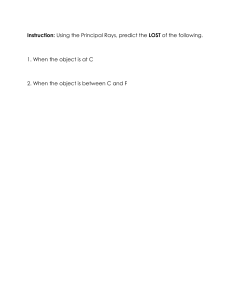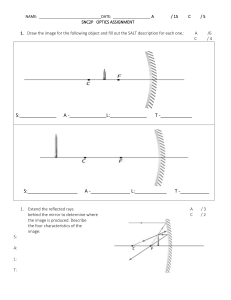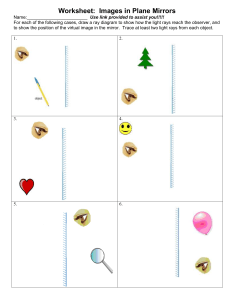
Plane Mirrors The Ray Model of Light • Light sources radiate light in all directions. The direction in which light travels is represented by lines with arrows (rays) on diagrams. • The basic property of light is that when it travels within the same medium, it moves in straight lines. • When light hits an object, depending on the properties of the object, light may be: Reflected • (bounced off the surface) • Ex. Mirror , metal plate Absorbed • stuck in the object and turn into other forms of energy, most often into heat). • If these either of these two properties are observed. • It is an Opaque Object • No light passes through the object. Transmitted • light rays go through the object in such a way that the pattern of the light rays does not change, or bend • Transparent • Transmitted pattern of the light rays changes (light get scattered) The way we see • Out of all the rays coming out of the object, a beam of narrow diverging light rays gets into the eye. • Brain extends these rays backward and estimates that there is an object at their intersection. The way we see • The eye receives a set of diverging light rays out of each point of the object. • The brain "draws" the object point-by-point, estimating each point at the intersection of diverging light rays. For simplicity, on this diagram only extreme points are analyzed The way we see in mirrors When the eye detects the light rays reflected by the mirror, the brain still assumes that what we see is at the intersection of the extensions of the light rays entering the eye. Observer has a sensation that the object is behind the mirror, but there is nothing behind the mirror. What we see is the Image: a pattern created by the light rays giving us sensation of the object reproduction. Terminology of Reflection The ray of light approaching the mirror is the incident ray The angle between the incident ray and the normal is the angle of incidence A line drawn perpendicular to the surface of the mirror at the point of incidence where the ray strikes the mirror, is known a normal line The ray of light which leaves the mirror is the reflected ray The angle between the reflected ray and the normal is the angle of reflection. Incident ray, reflected ray, and normal are in the same plane The Law of Reflection When a ray of light reflects off a surface, the angle of incidence is equal to the angle of reflection. Smooth surface vs Rough surface Same pattern of Pattern of reflected rays is reflected and incident different from the incident rays rays pattern Clear image Fuzzy picture or none Which reflection is diffuse? specular? Specular Diffuse Plane Mirror • A mirror is an object with smooth surface producing specular reflection of light • A plane mirror is a mirror with a flat reflective surface Image of a Point Image of a point Due to the similarity of the triangles on the diagram, all the reflected rays extend backward to one point. No matter where the observer is, the image is always: •Behind the mirror •On the perpendicular line drawn from the object, A. •At the same distance from the mirror as object. A do di A ’ Image Formation in Plane Mirrors by a Point Source of Light Because all the reflected light rays intersect at one point anyway, there is no need to construct many of them, but only one: the perpendicular to the surface of the mirror. A 1 do A’ di To construct the image of a point, -sketch a line perpendicular to the mirror through A - measure do (from A to the mirror surface) - construct image A' on the other side such as do= di Image Formation in Plane Mirrors To construct the image of an object, there is no need to construct an image of each single point of it. Construct an image of the extreme points (e.g. top and the bottom), then connect these edge points Properties of Images Formed by Plane Mirrors S ize A ttitude L ocation Type The image has the same size as the object (no magnification) The image is up-right but Laterally Inverted (Left / Right) Image is at the same distance from mirror as the object (see the next slide first) Type of the images formed by plane mirrors Our eye catches diverging rays reflected from mirror. Observer has a sensation that image is at the intersection of the light rays extended behind the mirror. There is nothing behind the mirror. Light only appears to us to come from this point.This image is imaginary, or virtual image because there is no real light rays going to or coming from behind the mirror. Properties of Images Formed by Plane Mirrors S ize A ttitude The image has the same size as the object (no magnification) The image is up-right but Laterally Inverted (Left / Right) L ocation Image is at the same distance from mirror as the object Type Plane mirrors form virtual images


